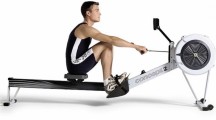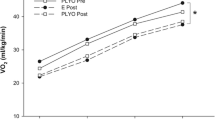Abstract
The purpose of this study was to propose a systematic method for the identification of training strategies and team selection using isoperformance curves. Rowing is a sport that relies on both aerobic and anaerobic energy contributions during a standard 2,000 m competition. The critical velocity model combines both aerobic (critical velocity, CV) and anaerobic (anaerobic rowing capacity, ARC) parameters in a single two-dimensional graphic display. The concept of isoperformance curves, a series of linear equations corresponding to minimum performance standards, allows for an objective overview of a large group of athletes of varying talent. The purpose of this study was to develop physiological profiles from the CV test, and to evaluate results with isoperformance curves to identify training strategies for collegiate rowers. Thirty-five female collegiate rowers completed four time trials over various distances (400, 600, 800, and 1,000 m). CV and ARC were calculated and compared between novice and varsity athletes. CV values for the varsity group were significantly higher than the novice group (P = 0.016). No significant differences were found between groups for ARC (P = 0.068). Mean and individual CV and ARC values were plotted on the x- and y-axes, respectively, and junior, collegiate, and elite isoperformance curves were developed using 2,000 m times from recent indoor rowing competitions. Stratification of athletes through isoperformance curves was used to identify specific training interventions (anaerobic and/or aerobic) needed to improve their 2,000 m performance. The information drawn from isoperformance curves and the parameters of the CV test can be used to provide an objective view of physiological capabilities and training needs on both an individual and team basis.





Similar content being viewed by others
References
Battista RA, Pivarnik JM, Dummer GM, Sauer N, Malina RM (2007) Comparisons of physical characteristics and performances among female collegiate rowers. J Sports Sci 25:651–657
Bouchard C, An P, Rice T, Skinner JS, Wilmore JH, Gagnon J, Perusse L, Leon AS, Rao DC (1999) Familial aggregation of VO2max response to exercise training: results from the HERITAGE Family Study. J Appl Physiol 87:1003–1008
Clingeleffer A, Naughton L, Davoren B (1994) Critical power may be determined from two tests in elite kayakers. Eur J Appl Physiol 68:36–40
Cunningham DA, Goode PB, Critz JB (1975) Cardiorespiratory response to exercise on a rowing and bicycle ergometer. Med Sci Sport Exer 7:37–43
Dekerle J, Sidney M, Hespel JM, Pelayo P (2002) Validity and reliability of critical speed, critical stroke rate, and anaerobic capacity in relation to front crawl swimming performances. Int J Sports Med 23:93–98
Di Prampero PE, Cortili G, Celentano F, Cerretelli P (1971) Physiological aspects of rowing. J Appl Physiol 31:853–857
Faff J, Bienko A, Burkhard-Jagodzinska K, Borkowski L (1993) Diagnostic value of indices derived from the critical power test in assessing the anaerobic work capacity of rowers. Biol Sport 10:9–14
Fiskerstrand Å, Seiler KS (2004) Training and performance characteristics among Norwegian international rowers 1970–2001. Scand J Med Sci Sports 14:303–310
Florence S, Weir JP (1997) Relationship of critical velocity to marathon running performance. Eur J Appl Physiol Occup Physiol 75:274–278
Fukuda DH, Smith AE, Kendall KL, Dwyer TR, Kerksick CM, Beck TW, Cramer JT, Stout JR (2010) The effects of creatine loading and gender on anaerobic running capacity. J Strength Cond Res 24:1826–1833
Gayagay G, Yu B, Hambly B, Boston T, Hahn A, Celermajer DS, Trent RJ (1998) Elite endurance athletes and the ACE I allele—the role of genes in athletic performance. Human Genet 103:48–50
Guellich A, Seiler S, Emrich E (2009) Training methods and intensity distribution of young world-class rowers. Int J Sports Physiol Perform 4:448–460
Hagerman FC (1984) Applied physiology of rowing. Sports Med 1:303–326
Hagerman FC, Connors MC, Gault JA, Hagerman GR, Polinski WJ (1978) Energy expenditure during simulated rowing. J Appl Physiol 45:87–93
Hagerman FC, Staron RE (1982) Seasonal-variations among physiological variables in elite oarsmen. Med Sci Sport Exer 14:143–148
Hazell TJ, Macpherson RE, Gravelle BM, Lemon PW (2010) 10 or 30-s sprint interval training bouts enhance both aerobic and anaerobic performance. Eur J Appl Physiol 110:153–160
Hill DW, Alain C, Kennedy MD (2003) Modeling the Relationship Between Velocity And Time To Fatigue In Rowing. Med Sci Sports Exerc 35:2098–2105
Hill DW, Ferguson CS (1999) A physiological description of critical velocity. Eur J Appl Physiol Occup Physiol 79:290–293
Hinckson EA, Hopkins WG (2005) Reliability of time to exhaustion analyzed with critical-power and log-log modeling. Med Sci Sports Exerc 37:696–701
Housh TJ, Cramer JT, Bull AJ, Johnson GO, Housh DJ (2001) The effect of mathematical modeling on critical velocity. Eur J Appl Physiol 84:469–475
Jenkins DG, Quigley BM (1990) Blood lactate in trained cyclists during cycle ergometry at critical power. Eur J Appl Physiol Occup Physiol 61:278–283
Jones AM, Vanhatalo A, Burnley M, Morton RH, Poole DC (2010) Critical power: implications for the determination of VO2max and exercise tolerance. Med Sci Sports Exerc 42:1876–1890
Kennedy MD, Bell GJ (2000) A comparison of critical velocity estimates to actual velocities in predicting simulated rowing performance. Can J Appl Physiol 25:223–235
Kolbe T, Dennis SC, Selley E, Noakes TD, Lambert MI (1995) The relationship between critical power and running performance. J Sports Sci 13:265–269
Maestu J, Cicchella A, Purge P, Ruosi S, Jurimae J, Jurimae T (2006) Electromyographic and neuromuscular fatigue thresholds as concepts of fatigue. J Strength Cond Res 20:824–828
Monod H, Scherrer J (1965) The work capacity of a synergic muscular group. Ergonomics 8:329–338
Moritani T, Nagata A, de Vries HA, Muro M (1981) Critical power as a measure of physical work capacity and anaerobic threshold. Ergonomics 24:339–350
Morton R (2006) The critical power and related whole-body bioenergetic models. Eur J Appl Physiol 96:339–354
Morton RH (2009) Isoperformance curves: an application in team selection. J Sports Sci 27:1601–1605
Perkins CD, Pivarnik JM (2003) Physiological profiles and performance predictors of a women’s NCAA rowing team. J Strength Cond Res 17:173–176
Schabort EJ, Hawley JA, Hopkins WG, Blum H (1999) High reliability of performance of well-trained rowers on a rowing ergometer. J Sports Sci 17:627–632
Secher NH (1993) Physiological and biomechanical aspects of rowing Implications for training. Sports Med 15:24–42
Seiler KS, Kjerland GO (2006) Quantifying training intensity distribution in elite endurance athletes: is there evidence for an “optimal” distribution? Scand J Med Sci Sports 16:49–56
Seiler KS, Spirduso WW, Martin JC (1998) Gender differences in rowing performance and power with aging. Med Sci Sports Exerc 30:121–127
Shephard RJ (1998) Science and medicine of rowing: a review. J Sport Sci 16:603–620
Shimoda M, Kawakami Y (2005) Critical power determination with ergometry rowing: relation to rowing performance. Int J Sport Health Sci 3:21–26
Simoneau J, Bouchard C (1995) Genetic determinism of fiber type proportion in human skeletal muscle. FASEB J 9:1091–1095
Smith AE, Fukuda DH, Kendall KL, Stout JR (2010) The effects of a pre-workout supplement containing caffeine, creatine, and amino acids during three weeks of high-intensity exercise on aerobic and anaerobic performance. J Int Soc Sports Nutr 7:10
Soper C, Hume PA (2004) Reliability of power output during rowing changes with ergometer type and race distance. Sports Biomech 3:237–248
Steinacker JM (1993) Physiological aspects of training in rowing. Int J Sports Med 14(Suppl 1):S3–S10
Yoshiga CC, Higuchi M (2003) Rowing performance of female and male rowers. Scand J Med Sci Sports 13:317–321
Author information
Authors and Affiliations
Corresponding author
Additional information
Communicated by William Kraemer.
Rights and permissions
About this article
Cite this article
Fukuda, D.H., Kendall, K.L., Smith, A.E. et al. The development of physiological profiles and identification of training needs in NCAA female collegiate rowers using isoperformance curves. Eur J Appl Physiol 111, 679–685 (2011). https://doi.org/10.1007/s00421-010-1683-4
Accepted:
Published:
Issue Date:
DOI: https://doi.org/10.1007/s00421-010-1683-4




